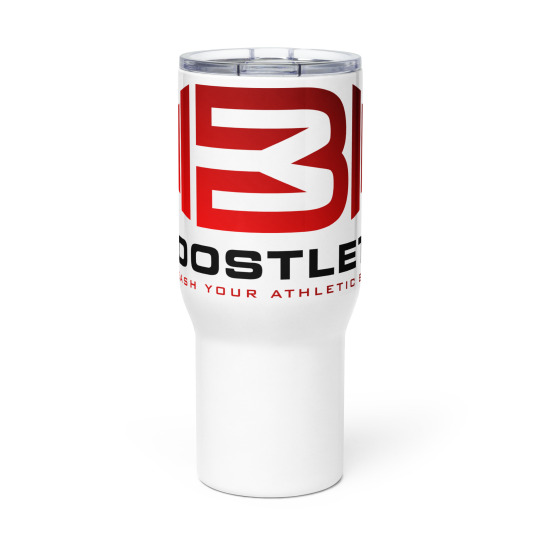Text
BOOSTLETE Travel Mug with Handle -16oz Insulated Stainless Steel Cup for Hot & Cold Drinks

Sip in style and comfort with an elevated travel mug. With its sleek and durable design, you’ll love taking this mug wherever you go. It fits into most car cup holders and has a spill-proof plastic lid. Commute to work or go on new adventures—this travel mug will keep your beverage safe and at just the right temperature.
• Made with stainless steel and BPA-free plastic
• Capacity: 25 oz (739 ml)
• Height: 7.9″ (20 cm)
• Upper diameter: 3.3″ (8.4 cm)
• Bottom diameter: 2.7″ (7 cm)
• Hand-wash only
Caution! To prevent steam pressure buildup, always open the lid before placing it on a hot drink.
Read the full article
0 notes
Text
What Happens When You Drink Turmeric and Ginger Every Day?

Turmeric and ginger both possess potency as anti-inflammatories, while their combination can soothe indigestion, boost immunity and support heart, skin and eye health.Drinking tea regularly is a delicious and healthy addition to your day, yet excessive consumption may increase oxalate excretion, potentially leading to kidney stones in some people.1. Reduces InflammationGinger and turmeric contain anti-inflammatory nutrients to provide protection from post-exercise inflammation or ease symptoms associated with rheumatoid arthritis, while also improving brain function and digestion. Take it from an athlete looking to reduce post-workout inflammation or someone suffering from arthritis; both can provide delicious solutions!Both turmeric and ginger belong to the rhizome family, making them easy to incorporate into either fresh meals or supplement forms. Turmeric boasts powerful antioxidants and compounds that fight inflammation throughout your body while having a vibrant orange hue that lends it its name - something ginger lacks.One of the greatest advantages of turmeric is its anti-inflammatory properties, due to the curcumin it contains. Unfortunately, this compound is only bioavailable to your body through small doses, so adding black pepper when taking turmeric supplements is recommended for maximum absorption.2. Boosts Brain FunctionCurcumin, a yellow pigment found in turmeric root spice, has become widely recognized for its health-boosting properties. This yellow pigment may help prevent disease, delay ageing, ease arthritis symptoms and more.Ginger has long been recognized for its antiviral properties; one study published in 2020 demonstrated this fact by showing how ginger inhibited growth of the common cold virus.Studies have shown that meditation increases levels of brain-derived neurotrophic factor protein, which may help with cognitive function and memory improvement. Furthermore, meditation may maintain healthy cholesterol levels if your numbers already fall within normal range as well as help manage stress more effectively.3. Supports Healthy Cholesterol LevelsGinger and turmeric both offer powerful anti-inflammatory benefits when taken alone; however, when combined together they become even more potency. Try mixing both roots for an incredible detox drink that supports immune system function while decreasing inflammation and improving digestion.Turmeric's purifying properties may cause blood-thinning effects, so it is best to consult your physician prior to consuming turmeric tea if you take medications for high blood pressure or blood thinners such as Warfarin (Coumadin). Furthermore, overconsumption of turmeric tea could stimulate labor contractions during pregnancy so if pregnant, beware and limit consumption of this tea!According to a 2019 study published in Phytotherapy Research, ginger and turmeric both can effectively lower high blood pressure among healthy adults, contributing to overall heart health when combined with other lifestyle modifications like healthy diet choices, regular physical activity and managing stress effectively.4. Boosts Immune SystemTurmeric boasts anti-inflammatory, antibacterial, and antifungal properties while being an excellent source of Vitamin C. Ginger provides similar immunity-boosting effects while its active compounds - known as gingerols - may help relax gastrointestinal muscles, alleviate nausea, and provide stomach pain relief.These ingredients belong to the rhizome family and should be enjoyed fresh or whole before being dried or powdered for optimal use. Both contain active compounds with strong antioxidant properties, including curcumin and gingerols which possess curative capabilities.Health-enhancing compounds aren't readily bioavailable on their own; when consumed together, though, their bioavailability increases by up to 2,000%! This makes this turmeric ginger drink perfect for supporting immunity as well as helping overcome colds or flu symptoms.5. Soothes Stomach DiscomfortTurmeric and ginger roots offer more than just delicious spice blends; they contain essential nutrients that provide numerous health benefits.Curcumin, a star anti-inflammatory compound found in turmeric, is widely believed to help ease arthritis and colitis pain. But according to a 2021 study published in Pharmaceutics, ginger may provide similar relief on inflammation-based conditions like rheumatoid arthritis - it even works better than ibuprofen!Ginger and turmeric both possess antioxidant properties, known to neutralize harmful free radicals found in your body that cause cell damage and contribute to diseases like cancer. Furthermore, these herbs help keep blood sugar and cholesterol levels within healthy range. However, it's wise to seek medical advice first before drinking either ginger or turmeric tea, particularly if you suffer from diabetes or high blood pressure.
Read the full article
0 notes
Text
Magnesium Glycinate Benefits

Magnesium glycinate can help improve sleep quality, relieve PMS symptoms, strengthen bones and teeth, and enhance overall health - but what exactly is this miracle mineral?
Magnesium can be found in many foods, such as leafy greens, avocado, bananas and fatty fish. You can also take it as a dietary supplement.
Boosts Energy
Many Americans are deficient in magnesium, an essential nutrient which can boost energy levels, ease fatigue, relax muscles and nerves, support bone health and manage blood pressure. Magnesium can be found in many food sources such as spinach, broccoli, pumpkin seeds and black beans; however, those suffering from digestive issues, medication side-effects or having chronic diarrhea may find it more challenging to absorb enough magnesium through diet alone.
Our magnesium glycinate supplement is bound to glycine, an amino acid naturally present in our bodies, to enhance absorption and make digestion simpler. It may cause less side effects like loose stools compared with citrate or oxide magnesium supplements; making this ideal for individuals with sensitive stomachs. Furthermore, this form of magnesium supports normal psychological functioning, muscle functioning and electrolyte balance.
Reduces Migraines
Magnesium deficiency can lead to several health complications, including migraine headaches. Studies have demonstrated how taking magnesium supplements can increase levels in the blood, helping decrease severity and frequency of migraine headaches.
Magnesium may help prevent migraine attacks by blocking NMDA receptors and inhibiting the release of pain-inducing chemicals in the brain. Once an attack begins, magnesium helps soothe symptoms by relaxing muscle spasms, widening blood vessels, and alleviating tension.
Magnesium glycinate can also help promote better sleep. Magnesium can alleviate anxiety and promote relaxation, both of which make it easier for the user to fall asleep at night - potentially even helping with insomnia!
As part of your daily regimen, add magnesium glycinate supplements from our Wellness Shop without needing a valid prescription. Other Cove products designed to promote good sleeping include buckwheat pillows and Super B dietary supplements which contain riboflavin, vitamin C and folate (B9) to maintain optimal cellular energy production.
Helps You Sleep
Magnesium glycinate can be an invaluable help for those experiencing difficulty sleeping or insomnia, helping reduce stress and anxiety levels and promote relaxation and stimulating production of melatonin.
Magnesium glycinate has also been found to aid fatigue by supporting neurotransmitter function and mood regulation, and is an essential nutrient for maintaining normal blood pressure and lowering risk for cardiovascular diseases.
Magnesium glycinate can provide significant stress-reliever and migraine-headache prevention benefits. You can obtain this essential nutrient through food sources like dark leafy green vegetables, legumes, nuts and bananas; alternatively it can be taken in supplement form. Prior to beginning any new supplement regimen including magnesium glycinate it's wise to consult your healthcare provider first to make sure it's suitable and determine how much to take at once.
Helps You Stay Healthy
Magnesium glycinate is widely recognized for having superior bioavailability over magnesium oxide and citrate, meaning that your body finds it easier to absorb. Furthermore, magnesium glycinate is less likely to cause digestive issues like diarrhea compared to these options, making it suitable for people with sensitive stomachs.
Helps lower blood pressure and prevent hypertension; lowers cardiovascular disease risk by lowering blood sugar levels; helps alleviate anxiety and PMS symptoms by decreasing prostaglandin release that trigger pain, mood swings and fatigue; can also reduce PMS symptoms by helping control prostaglandin release that causes them.
As magnesium deficiency is relatively uncommon, certain health conditions and medications may lead to decreased levels of this essential mineral. If you suspect having one, or believe you might, talk with your physician about taking supplements - they will recommend the right dose for your specific needs and provide advice on interacting with any medications you might be taking as well as testing levels to ensure they're within normal ranges.
Read the full article
0 notes
Text
CBD edibles benefits

CBD edibles offer an easy way to consume natural cannabinoids. You'll find these delicious treats everywhere from breath mints and honey to chocolate bars and dried fruit.
These supplements interact with the ECS to produce beneficial effects, including pain relief, decreased anxiety and stress levels, and better sleeping.
1. Discreet
CBD edibles offer a discreet method of enjoying its benefits, and are an ideal option for those who don't wish to carry around a vape or CBD tincture bottle.
CBD gummies are an easy and fast way to quickly take their daily CBD dosage, offering fast relief from stress and anxiety as well as pain management. Also taking CBD an hour before bed can improve sleep quality.
When purchasing CBD gummies, look for those without processed sugar or cheap filler ingredients, such as cornstarch. Instead, look for organic varieties which are free from pesticides and chemicals which could potentially be damaging to your health. There's also an array of flavors to meet individual preferences; many CBD edibles use an isolate form which means plant compounds have been removed for a more pure experience and stronger effects from each bite.
2. Easy
CBD edibles offer an ideal way to incorporate this popular supplement into your everyday routine. Not only are they appetizing, easy, and discreet - there are even varieties made with organic ingredients tested by third-party laboratories for safety!
Consuming CBD edibles requires first breaking it down in the digestive system before being absorbed by your bloodstream, thus decreasing bioavailability when compared with sublingual consumption.
To maximize the effectiveness of your CBD edible, select products made from organic non-GMO hemp that do not contain heavy metals, pesticides or solvents. It is wise to read the label of your CBD edible carefully and start off slowly; taking more than you intended may result in dizziness, fatigue, dry mouth or nausea - read it thoroughly to avoid this mistaken decision!
3. Tasty
Integrating CBD into food is an effortless and straightforward way to incorporate it into recipes. You can add it to everything from salad dressings and sauces like BBQ or wing sauce, to cold desserts such as ice cream. However, you must first decarboxylate and cook the CBD in high-quality cooking oil (not butter) prior to adding it into any of your recipes; this process allows the fat in the oil to combine with cannabinoids more readily for easy consumption.
CBD has been shown to offer relief for various conditions, including pain, nausea, psychosis or mental disorders and gastrointestinal issues. Furthermore, its bronchodilatory properties could potentially help patients suffering from COPD improve their lung function by increasing airflow into and out of their lungs.
4. Healthy
CBD-infused products do not produce psychotropic highs like THC edibles do; instead they're completely safe to ingest and may help those addicted to other THC-containing products break their dependence.
Studies indicate that CBD can help manage various medical conditions. A recent rheumatoid arthritis study involving Sativex, a CBD-based botanical drug, showed statistically significant improvements in sleep quality, pain during movement and pain at rest for patients receiving this therapy. Furthermore, other research indicates CBD's potential ability to reduce seizure frequency among children suffering from Lennox-Gastaut and Dravet syndromes while improving their overall quality of sleep and quality.
When purchasing CBD products, look for those made with superior broad spectrum hemp extract which contains naturally occurring cannabinoids such as CBG, CBN and terpenes. Third-party laboratory testing shows quality assurance as it ensures ingredient accuracy and label accuracy as part of transparency efforts by the company.
Read the full article
0 notes
Text
What Are the Benefits of Krill Oil?

Krill oil contains omega-3 essential fatty acids that help control cholesterol levels, support brain health and boost heart health.
Krill oil contains astaxanthin, an antioxidant which reduces inflammation and has anti-aging benefits. Studies suggest it could potentially treat arthritis pain, premenstrual syndrome depression and other conditions; however, more research needs to be conducted in this field.
Lowers Cholesterol
Krill oil contains omega-3 fatty acids EPA and DHA which have been shown to effectively lower both cholesterol and triglycerides. A study demonstrated this by showing how taking 4 grams daily reduced triglycerides by 12.7% while increasing HDL cholesterol.
Krill oil contains astaxanthin, an extremely effective antioxidant which protects the body against free radical damage and provides essential EPA and DHA for skin health, contributing to glowing complexions.
Krill oil is generally safe to take, though as with any nutritional supplement it's wise to consult a registered dietitian or healthcare provider prior to taking. Furthermore, those allergic to seafood, blood thinners or medication for anti-diabetes or antibiotic use should avoid it as this supplement.
Lowers Inflammation
Krill oil's omega-3 fatty acids, particularly EPA, possess powerful anti-inflammatory properties which can help lower cholesterol, improve cardiovascular health, decrease joint pain and autoimmune disorders risk and more.
Natural killer cells play an essential role in combatting cancerous and precancerous cells. Choline plays an integral part of supporting immunity.
EPA and DHA present in krill oil have been shown to promote heart health by helping reduce triglycerides, blood pressure and resting heart rate. Furthermore, astaxanthin plays an antioxidant role protecting cells against damage and oxidation - making krill oil even better for heart health than fish oils (18).
Supports Eye Health
Krill oil's omega-3 fatty acids are bound to phospholipids, making them more bio-available than fish oils containing triglycerides and thus providing for easier absorption and providing a greater dose of omega-3s within smaller capsules.
Krill oil's phosphatidylcholine content can help strengthen and preserve your eye's oil film barrier, keeping them moist and comfortable. According to studies, using krill oil regularly may reduce symptoms associated with dry eye syndrome or even help to prevent them from appearing altogether.
Astaxanthin found in krill oil is well known to combat oxidative stress and free radical damage to eyes, brain and body. Furthermore, astaxanthin supports immunity - something which becomes especially essential during cold and flu season when maintaining strong immunity is key to remaining healthy.
Supports Joint Health
Research indicates krill oil can help relieve arthritis symptoms such as pain, stiffness and numbness, while simultaneously decreasing levels of C reactive protein associated with increased inflammation.
Rheumatoid arthritis sufferers frequently experience excruciating joint pain. Studies show that when taking krill oil for 30 days, their symptoms improve significantly and require less anti-inflammatory drugs to manage them.
Another study conducted and published in the "American Journal of Clinical Nutrition" discovered that krill oil and fish oil work together to combat inflammation at multiple levels and optimize arthritis control. Researchers discovered that those taking both types of oils experienced greater relief for knee osteoarthritis pain relief than those only taking fish oil supplements alone.
Supports Mental Health
Krill oil contains antioxidants to defend against free radical damage to DNA. Its anti-inflammatory properties may help prevent cancer and lower insulin resistance - contributing to diabetes and metabolic syndrome - but may also prove helpful against anxiety, osteoarthritis and PMS symptoms; although more rigorous clinical trials with larger groups would likely prove more conclusive results.
An 11-month, double-blind placebo controlled krill oil supplementation trial was conducted with two cohorts. Participants in Cohort 1 started off taking 400 mg EPA and DHA while those in Cohort 2 took up to 800 mg each day EPA/DHA; blood fatty acid concentrations were measured at baseline as well as three, six and 12 months post infusion; the CES-D and Rosenberg Self Esteem scores were also compared between both groups.
Read the full article
0 notes
Text
Sea Moss Benefits and Side Effects

Sea moss has quickly become a beloved ingredient and health supplement. Packed full of minerals, vitamins, polyunsaturates fats and iodine for supporting thyroid function and metabolic balance, sea moss provides many essential elements to maintain good health and to increase thyroid performance.
However, as with any food or dietary supplement, there may be potential side effects.
Carrageenan
Carrageenan, an organic substance derived from seaweed, can be used as an effective food thickener. Studies have also demonstrated its beneficial effects in terms of cholesterol levels and blood sugar spikes. Furthermore, its high fiber content makes you feel full and reduces overeating risks; moreover it's packed full of essential minerals like calcium, potassium, magnesium, and iron!
Though sea moss may provide benefits, it's wise to consult your healthcare provider prior to adding any new foods or supplements into your diet - especially if you have preexisting conditions or medications you are currently taking - in order to receive tailored advice that ensures it's safe.
Chondrus crispus, more commonly known as sea moss, is an edible red seaweed abundant in vitamins and minerals such as iodine, potassium, calcium, magnesium, zinc and iron. As well as being an effective natural food thickener it's often credited with improving digestive health as well.
Iodine
Sea moss is packed with essential vitamins and nutrients, such as calcium, iodine, magnesium, potassium, iron and omega 3 fatty acids. Furthermore, it contains antioxidants which reduce inflammation to help protect against chronic illnesses like diabetes, heart disease and arthritis.
Another benefit of seaweed is its soluble fiber content, which may help with weight loss by making people feel full. Similar to chia seeds or aloe vera in this regard.
Be careful when adding sea moss to your diet if you have thyroid issues; its high iodine content could potentially cause goiter or an enlarged thyroid gland, so seek medical advice first before adding sea moss into your daily regimen. Also avoid it if you are allergic to shellfish; those on blood thinners or with inflammatory bowel disease; start small and gradually increase consumption over time; for best results purchase from reliable sources that adhere to stringent quality standards such as the United State Pharmacopeia (USP), National Science Foundation (NSF), or UL Empowering Trust stamp.
Allergic reactions
Sea moss is harvested as a natural thickening agent and used in products like ice cream, cottage cheese, nondairy milk, baby formula and health supplements. Packed full of minerals and vitamins such as immune-boosting vitamin C as well as antioxidants it absorbs pollutants and heavy metals from its environment; people allergic to seafood proteins can safely consume sea moss as it does not contain fish proteins.
Sea moss' high concentrations of omega 3 oils, chlorophyll and potassium make it an effective natural antihistamine that can aid in respiratory allergies. These nutrients work to dissolve phlegm buildup in lungs and improve breathing capacity, alleviating symptoms like sneezing, watery eyes and congestion while soothing inflammation from asthma or chronic obstructive pulmonary disease (COPD). Furthermore, some research indicates that eating sea moss could potentially prevent salmonella spreading within humans - however more research must be conducted into this possibility before definitive results can be confirmed.
Digestive discomfort
Although sea moss is widely touted for its nutritional benefits, indulging too heavily could have adverse side effects. Too much sea moss may lead to an excess of iodine that could adversely impact thyroid function as well as interfere with medications that work against blood thinning - individuals with preexisting thyroid conditions should consult a healthcare provider prior to taking sea moss supplements.
Consuming sea moss may cause gas and bloating, though this should subside once your body adjusts to eating it. People new to eating it should start slowly by starting with small amounts and gradually increasing their consumption over time.
Although there is not a lot of scientific evidence supporting sea moss' health benefits, many claim it aids weight loss, heart health and digestion. Unfortunately, most research on sea moss' medicinal uses involves test tubes or animals only; more human trials must be conducted on this topic in order to make solid conclusions. Furthermore, sea moss can contain heavy metals; therefore only use high-quality products when purchasing sea moss supplements.
Read the full article
0 notes
Text
Ashwagandha benefits: What you need to know

Introduction
Ashwagandha, also known as Withania somnifera, is a powerful and versatile herb that has been used for centuries in traditional Ayurvedic medicine. This ancient herb is known for its adaptogenic properties, which help the body cope with stress and promote overall well-being.
Benefits of Ashwagandha
Reduced Stress and Anxiety
Ashwagandha has been shown to reduce levels of cortisol, the stress hormone, in the body. By lowering cortisol levels, this herb can help reduce feelings of stress and anxiety, promoting a sense of calm and relaxation.
Enhanced Brain Function
Studies have suggested that ashwagandha may have neuroprotective properties and can help improve cognitive function. It may enhance memory, attention, and overall brain performance.
Increased Energy and Stamina
Ashwagandha is believed to boost energy levels and enhance physical performance. It may improve endurance, reduce fatigue, and increase overall stamina, making it a popular herb among athletes and individuals with an active lifestyle.
Improved Sleep Quality
This herb has been traditionally used as a sleep aid. Ashwagandha may help regulate sleep patterns, promote deep and restful sleep, and improve overall sleep quality.
Hormonal Balance
Ashwagandha has been shown to support hormonal balance, particularly in women. It may help regulate menstrual cycles, reduce symptoms of PMS, and support reproductive health.
Immune System Support
Ashwagandha contains antioxidant properties that help strengthen the immune system. It may help protect against infections, reduce inflammation, and promote overall immune health.
How to Use Ashwagandha
Ashwagandha can be taken in various forms, including capsules, powder, or as a liquid extract. It is recommended to follow the dosage instructions provided on the product packaging or consult with a healthcare professional for personalized guidance.
Conclusion
Ashwagandha is a powerful herb with numerous health benefits. From reducing stress and anxiety to enhancing brain function and supporting hormonal balance, this ancient Ayurvedic herb has a lot to offer. Incorporating ashwagandha into your daily routine may help improve overall well-being and promote a healthier lifestyle.
Remember, before starting any new herbal supplement, it's always best to consult with a healthcare professional for personalized advice and guidance.
Side Effects of Ashwagandha
While ashwagandha is generally considered safe for most people when taken in recommended doses, it's important to be aware of potential side effects. Some individuals may experience:
- Upset stomach or digestive issues: Ashwagandha may cause gastrointestinal discomfort, including stomach upset, diarrhea, or nausea in some people.
- Drowsiness or sedation: This herb can have a calming effect on the body and may cause drowsiness, especially when taken in higher doses or in combination with other sedative medications.
- Low blood pressure: Ashwagandha has been shown to have a mild hypotensive effect, which means it may lower blood pressure. If you have low blood pressure or are taking medications for hypertension, it's important to monitor your blood pressure levels closely.
- Allergic reactions: Although rare, some individuals may be allergic to ashwagandha. If you experience any signs of an allergic reaction, such as rash, itching, swelling, or difficulty breathing, seek medical attention immediately.
- Interactions with medications: Ashwagandha may interact with certain medications, including sedatives, thyroid medications, and immunosuppressants. It's important to consult with a healthcare professional if you're currently taking any medications to ensure there are no potential interactions.
It's always recommended to start with a lower dose of ashwagandha and gradually increase it, while monitoring your body's response. If you experience any severe or persistent side effects, discontinue use and consult with a healthcare professional.
Please note that the information provided here is for informational purposes only and should not replace professional medical advice. If you have any concerns or questions about ashwagandha's potential side effects, it's best to consult with a healthcare professional.
Recommended Doses of Ashwagandha
The recommended dosage of ashwagandha can vary depending on factors such as age, overall health, and the specific product being used. It's always best to follow the dosage instructions provided on the product packaging or consult with a healthcare professional for personalized guidance.
Here are some general guidelines for ashwagandha dosage:
- Powdered form: A typical recommended dose of ashwagandha powder is 1-2 grams per day. This can be divided into multiple smaller doses taken throughout the day.
- Capsules or tablets: If using ashwagandha in capsule or tablet form, the recommended dosage is usually around 300-500 milligrams taken once or twice daily. Again, it's important to check the specific product instructions for accurate dosing information.
- Liquid extract: Ashwagandha extract is often available in liquid form. The recommended dosage can vary, but a common guideline is around 2-4 milliliters taken once or twice daily.
It's worth noting that ashwagandha may take some time to show its effects, and it's often recommended to take it consistently for several weeks to experience its full benefits. As always, it's best to consult with a healthcare professional for personalized dosing instructions based on your individual needs and health condition.
Please remember that this information is for informational purposes only and should not replace professional medical advice. If you have any concerns or questions about the appropriate dosage of ashwagandha for you, consult with a healthcare professional.
Effects of Ashwagandha
The time it takes to see the effects of ashwagandha may vary from person to person. While some individuals may experience noticeable benefits within a few weeks, others may require a longer period of consistent use before experiencing the full effects.
It's important to remember that ashwagandha is not a quick-fix solution and its effects may be gradual and cumulative. The herb's adaptogenic properties work to support the body's overall balance and well-being over time.
Some individuals may start to experience improvements in stress levels, energy levels, and sleep quality within a few weeks of regular use. Others may notice benefits such as enhanced cognitive function, hormonal balance, and immune system support after a few months of consistent use.
It's worth mentioning that the effects of ashwagandha can also depend on factors such as the dosage used, individual body chemistry, lifestyle factors, and overall health condition.
If you're considering using ashwagandha for specific health concerns or conditions, it's always best to consult with a healthcare professional for personalized advice and guidance. They can help determine the appropriate dosage and provide a better understanding of when you can expect to see the effects based on your individual circumstances.
Please note that this information is for informational purposes only and should not replace professional medical advice. If you have any concerns or questions about the effects of ashwagandha, it's best to consult with a healthcare professional.
Ashwagandha and Hormonal Balance
Ashwagandha is believed to have the potential to support hormonal balance, particularly in women. While more research is needed to fully understand the mechanisms at play, here are some ways in which ashwagandha may contribute to hormonal balance:
- Stress Reduction: Ashwagandha is known for its adaptogenic properties, which help the body cope with stress. Chronic stress can disrupt hormonal balance, leading to imbalances in hormones such as cortisol, estrogen, progesterone, and testosterone. By reducing stress levels, ashwagandha may indirectly support hormonal balance.
- Thyroid Health: The thyroid gland plays a crucial role in regulating hormone production and metabolism. Ashwagandha has been shown to have a positive impact on thyroid function, helping to balance thyroid hormones. This, in turn, may contribute to overall hormonal balance.
- Reduced Menopausal Symptoms: Ashwagandha may be beneficial for women experiencing menopausal symptoms such as hot flashes, mood swings, and sleep disturbances. Studies have suggested that ashwagandha can help reduce the severity of these symptoms and improve overall quality of life during menopause.
- Improved Reproductive Health: Ashwagandha has been traditionally used to support reproductive health in women. It may help regulate menstrual cycles, reduce symptoms of premenstrual syndrome (PMS), and support fertility.
It's important to note that individual experiences with ashwagandha's effects on hormonal balance may vary. It's always best to consult with a healthcare professional for personalized advice, especially if you have specific hormonal concerns or conditions.
Please remember that this information is for informational purposes only and should not replace professional medical advice. If you have any concerns or questions about ashwagandha's effects on hormonal balance, it's best to consult with a healthcare professional.
Read the full article
0 notes
Text
Why Wellness Apparel Is a Game-Changer for Your Fitness Routine

Introduction to Wellness Apparel in the Fitness World
Wellness apparel is more than just your average gym clothes. Think of it as your workout partner, designed not just to make you look good but to enhance your performance and comfort during exercise. This type of clothing is engineered with materials that wick away sweat, keep you cool or warm depending on your exercise environment, and even reduce odor. What sets wellness apparel apart is its ability to support your body’s movements and, in some cases, improve your form. From compression leggings that promote blood flow to shirts that can track your heart rate, this gear uses technology to take your fitness game to the next level. No wonder more and more people are making the switch. Think of it; if your clothes can make your workout more effective or comfortable, why wouldn’t you try them? Whether you’re a seasoned athlete or just starting out, incorporating wellness apparel into your routine can make a noticeable difference.
The Various Types of Wellness Apparel
Wellness apparel goes beyond the look. It’s about wearing something that boosts your performance and comfort while you sweat it out. There’re a few types you’ll want to know about. Compression gear is a biggie. This stuff is tight, but in a good way. It’s supposed to increase blood circulation and reduce muscle fatigue. Next up, moisture-wicking clothing. When you’re pushing hard, you’re going to sweat. This gear pulls the sweat away from your skin, helping you stay dry and comfortable. Breathable fabrics are also key. These allow air to flow through, which keeps you from overheating. Then, there are temperature control clothes. Whether it’s keeping you warm on a chilly jog or cool under the sun, these pieces adjust to help regulate your body temp. Lastly, anti-odor technology is something to look out for. It prevents the growth of odor-causing microbes, so you stay fresh longer. Each type plays a role in maximizing your workout. Mix and match based on your needs and the conditions you’re facing.
Benefits of Incorporating Wellness Apparel into Your Fitness Routine
When you throw on wellness apparel before a workout, you’re not just dressing for the part; you’re giving your fitness routine a serious upgrade. First off, this gear is designed with your performance in mind. Imagine running shorts that reduce chafing, or yoga pants that move seamlessly with you. Sounds good, right? Plus, many of these pieces come with moisture-wicking technology. This means you stay dryer and more comfortable, no matter how intense your workout gets. And let’s not forget about the compression wear. These items are real game-changers. They help improve blood flow, reduce muscle fatigue, and speed up recovery time. So, you can push harder today and be ready to do it all over again tomorrow. Lastly, there’s a mental boost in wearing clothes that make you feel good. When you look in the mirror and see a serious athlete staring back, you’re more likely to act like one. It’s about feeling confident in your journey towards health and fitness. In short, incorporating wellness apparel into your routine is like giving yourself an extra edge. You’ll perform better, recover faster, and even boost your self-esteem. Now, who wouldn’t want that?
How Wellness Apparel Can Enhance Your Workout Performance
Wellness apparel does more than just make you look good while working out. It’s engineered to boost your performance, comfort, and safety. Let’s start with performance. Materials in fitness clothing today are designed to pull sweat away from your body. This keeps you dry and comfortable, allowing you to focus on pushing harder and longer in your workouts. Now, think about comfort. These clothes fit better because they’re made to move with your body. You won’t find yourself pulling at your shirt during a run or adjusting your pants during yoga. This means you can concentrate on your form and exercise, not on what you’re wearing. Safety is key too. The right gear, like reflective items for night runs or compression wear to support muscles, reduces your risk of injury. In a nutshell, investing in quality wellness apparel is investing in your workout results. You feel better, perform better, and stay safer.
The Role of Technology in Wellness Apparel
Tech isn’t just for gadgets anymore; it’s revolutionizing your workout wear too. Thanks to smart textiles, your gym clothes can do a lot more than just look good. These innovative fabrics can monitor your heart rate, track your body’s movement, and even measure how much you’re sweating. Imagine wearing a shirt that tells you how hard you’re working out and adjusts to keep your body at the ideal temperature. That’s not future talk; it’s what’s happening right now. Compression wear is another tech feat. It boosts circulation, which can help with muscle recovery and reduce soreness after a workout. So, when you slip into your fitness gear, remember it’s not just fabric covering your body; it’s a high-tech tool designed to enhance your performance and overall wellness. Think of it as having a personal trainer and a physiotherapist built into your clothes. In the world of fitness, where every edge counts, this tech-infused apparel can be a real game-changer.
Choosing the Right Wellness Apparel for Your Exercise Needs
When it comes to leveling up your workout, wearing the right wellness apparel is crucial. Think of it this way—the clothes you pick can either boost your performance or hold you back. So, what should you look for? First, consider the fabric. You want materials that pull sweat away from your skin and help it evaporate quickly. Cotton, while comfy, can stay wet. On the other hand, synthetic fabrics like polyester are excellent at keeping you dry. Next, think about the fit. Clothes that are too tight can restrict your movement, and too loose can get in the way. Opt for a fit that allows full range of motion. Also, the right gear can prevent injuries. For example, compressive garments support your muscles and reduce the risk of strains. Lastly, don’t forget about the tech features. Some apparel comes with UV protection, odor resistance, and even reflective details for night exercises. By focusing on these aspects, you’ll not only feel good and stay safe during your workouts but also potentially enhance your performance and enjoyment.
Caring for Your Wellness Apparel to Ensure Longevity
Taking care of your wellness apparel isn’t rocket science, but it sure makes a difference in ensuring they last long and support your fitness journey effectively. First off, always check the care label - that’s your apparel’s diary, telling you exactly what it loves and hates. Mainly, turn your gear inside out before washing. This simple move protects the color and reduces the wear on the fabric. Stick to cold water. Hot water is a big no as it can break down the fibers and fade the color. Avoid fabric softeners; they’re like kryptonite to the stretchiness in your fitness wear.
Then there’s the drying game. Air drying is king. It’s gentle, and unlike dryers, it won’t shrink or warp your clothes out of shape. If you must use a dryer, opt for a low or no-heat setting. Remember, high heat is a villain to your apparel’s elasticity.
Got stubborn stains or odors? Pre-soak or spot treat them with gentle, natural solutions before you wash.
In a nutshell, caring for your wellness apparel might need a bit of your time and attention, but it pays off by extending the life of your clothes, saving you money, and ensuring you look good while hitting your fitness goals. Treat them right, and they’ll be your workout buddies for a long time.
Real-Life Success Stories: The Impact of Wellness Apparel
People from all walks of life are finding that swapping their regular workout clothes for wellness apparel makes a big difference. Take Jake, for instance, a casual runner who switched to compression leggings. He noticed fewer muscle aches and quicker recovery times almost immediately. Then there’s Maria, a yoga enthusiast. She claims her moisture-wicking yoga pants not only keep her dry and comfortable but also boost her confidence, making her more committed to her practice. Alex, a gym-goer, praises the way his performance shirts help regulate his body temperature, allowing him to focus more on his workout and less on feeling overheated or chilled. These real-life stories highlight how making a simple change in what you wear to exercise can enhance your performance, comfort, and overall dedication to staying active. No fancy equipment needed—just the right gear to help your body perform at its best.
Tips for Integrating Wellness Apparel into Your Daily Fitness Regimen
To get the most out of your wellness apparel, you don’t need to overhaul your wardrobe overnight. Start small. Swap out that old cotton t-shirt for a moisture-wicking top for your next run. Notice the difference? That’s wellness apparel in action, keeping you dry and comfortable. Next, consider your footwear. A good pair of shoes can change the game, providing the right support for your activity of choice. Be it running, lifting, or yoga, there’s footwear designed to maximize your performance. Now, let’s talk about compression gear. It’s not just for athletes anymore. Adding compression leggings or socks to your outfit can improve circulation and reduce muscle fatigue. This means you can push a bit harder and recover a bit faster. Finally, don’t forget accessories. A breathable hat for outdoor activities or a pair of gloves for those chilly morning runs can make a big difference. Remember, incorporating wellness apparel into your routine is about enhancing your performance and comfort. Start with one piece, feel the improvement, and build from there. You’ll notice your workouts elevating in no time.
Conclusion: The Future of Fitness with Wellness Apparel
Wellness apparel is not just a trend; it’s revolutionizing the way we approach fitness. By incorporating technology that monitors health metrics and enhances comfort, these clothes are becoming an essential part of our workout routines. As we move forward, the impact of wellness apparel on our fitness journeys is only going to grow. Expect to see more advanced features, from fabric that adjusts to your body temperature to designs that improve posture. With every stitch aimed at boosting your performance and health, wellness apparel is indeed shaping the future of fitness. Investing in these innovative garments isn’t just about looking good; it’s about making every workout count, staying motivated, and reaching your health goals faster.
Read the full article
0 notes
Link
1 note
·
View note